Enhancing Informed Decisions for Coastal Groundwater Sustainability: A Network Analysis of Water-Related Indicator Results from 122 Cities
Abstract
1. Introduction
2. Materials and Methods
2.1. Study Area
2.2. City Blueprint Approach
2.3. Correlation Analysis
2.4. Construction of City Blueprint Network
2.5. Metrics for Network Analysis
3. Results
3.1. City Blueprint of Busan and Incheon
3.2. The Groundwater-Centered CB Network
3.3. Results of CB Network Analysis
4. Discussion
5. Conclusions
Supplementary Materials
Author Contributions
Funding
Data Availability Statement
Conflicts of Interest
References
- Vörösmarty, C.J.; Green, P.; Salisbury, J.; Lammers, R.B. Global Water Resources: Vulnerability from Climate Change and Population Growth. Science 2000, 289, 284–288. [Google Scholar] [CrossRef]
- He, C.; Liu, Z.; Wu, J.; Pan, X.; Fang, Z.; Li, J.; Bryan, B.A. Future global urban water scarcity and potential solutions. Nat. Commun. 2021, 12, 4667. [Google Scholar] [CrossRef]
- McDonald, R.I.; Green, P.; Balk, D.; Fekete, B.M.; Revenga, C.; Todd, M.; Montgomery, M. Urban growth, climate change, and freshwater availability. Proc. Natl. Acad. Sci. USA 2011, 108, 6312–6317. [Google Scholar] [CrossRef] [PubMed]
- McDonald, R.I.; Weber, K.; Padowski, J.; Flörke, M.; Schneider, C.; Green, P.A.; Gleeson, T.; Eckman, S.; Lehner, B.; Balk, D.; et al. Water on an urban planet: Urbanization and the reach of urban water infrastructure. Glob. Environ. Chang. 2014, 27, 96–105. [Google Scholar] [CrossRef]
- Aeschbach-Hertig, W.; Gleeson, T. Regional strategies for the accelerating global problem of groundwater depletion. Nat. Geosci. 2012, 5, 853–861. [Google Scholar] [CrossRef]
- Li, P.; Karunanidhi, D.; Subramani, T.; Srinivasamoorthy, K. Sources and consequences of groundwater contamination. Arch. Environ. Contam Toxicol. 2021, 80, 1–10. [Google Scholar] [CrossRef] [PubMed]
- Michael, H.A.; Post, V.E.A.; Wilson, A.M.; Werner, A.D. Science, society, and the coastal groundwater squeeze. Water Resour. Res. 2017, 53, 2610–2617. [Google Scholar] [CrossRef]
- Chang, S.W.; Chung, I.M.; Kim, M.G.; Tolera, M.; Koh, G.W. Application of GALDIT in assessing the seawater intrusion vulnerability of Jeju Island, South Korea. Water Switz. 2019, 11, 1824. [Google Scholar] [CrossRef]
- Werner, A.D.; Bakker, M.; Post, V.E.A.; Vandenbohede, A.; Lu, C.; Ataie-Ashtiani, B.; Simmons, C.T.; Barry, D.A. Seawater intrusion processes, investigation and management: Recent advances and future challenges. Adv. Water Resour. 2013, 51, 3–26. [Google Scholar] [CrossRef]
- Gleeson, T.; Cuthbert, M.; Ferguson, G.; Perrone, D. Global Groundwater Sustainability, Resources, and Systems in the Anthropocene. Annu. Rev. Earth Planet. Sci. 2020, 48, 431–463. [Google Scholar] [CrossRef]
- Alley, W.M.; Reilly, T.E.; Franke, O.L. Sustainability of Ground-Water Resources; US Geological Survey; US Department of the Interior: Washington, DC, USA, 1999; Volume 1186, ISBN 0607930403.
- Hosseini, S.M.; Parizi, E.; Ataie-Ashtiani, B.; Simmons, C.T. Assessment of sustainable groundwater resources management using integrated environmental index: Case studies across Iran. Sci. Total Environ. 2019, 676, 792–810. [Google Scholar] [CrossRef]
- Aguirre-Muñoz, A.; Buddemeier, R.W.; Camacho-Ibar, V.; Carriquiry, J.D.; Ibarra-Obando, S.E.; Massey, B.W.; Smith, S.V.; Wulff, F. Sustainability of coastal resource use in San Quintin, Mexico. AMBIO J. Hum. Environ. 2001, 30, 142–149. [Google Scholar] [CrossRef] [PubMed]
- Pires, A.; Morato, J.; Peixoto, H.; Botero, V.; Zuluaga, L.; Figueroa, A. Sustainability Assessment of indicators for integrated water resources management. Sci. Total Environ. 2017, 578, 139–147. [Google Scholar] [CrossRef] [PubMed]
- Brown, C.M.; Lund, J.R.; Cai, X.; Reed, P.M.; Zagona, E.A.; Ostfeld, A.; Hall, J.; Characklis, G.W.; Yu, W.; Brekke, L. The future of water resources systems analysis: Toward a scientific framework for sustainable water management. Water Resour. Res. 2015, 51, 6110–6124. [Google Scholar] [CrossRef]
- Incheon Metropolitan City, Groundwater Management Plan of Incheon. 2017. Available online: https://www.gims.go.kr/natnMngSchd.do?tgu=B&sgu=47&Activeidx=0 (accessed on 18 December 2021).
- Busan Metropolitan City, Groundwater Management Plan of Busan. 2015. Available online: https://www.gims.go.kr/natnMngSchd.do?tgu=B&sgu=44&Activeidx=0 (accessed on 18 December 2021).
- Koop, S.H.A.; Van Leeuwen, C.J. Application of the Improved City Blueprint Framework in 45 Municipalities and Regions. Water Resour. Manag. 2015, 29, 4629–4647. [Google Scholar] [CrossRef]
- Koop, S.H.A.; Van Leeuwen, C.J. Assessment of the Sustainability of Water Resources Management: A Critical Review of the City Blueprint Approach. Water Resour. Manag. 2015, 29, 5649–5670. [Google Scholar] [CrossRef]
- Albert, R.; Jeong, H.; Barabási, A.-L. Error and attack tolerance of complex networks. Nature 2000, 406, 378–382. [Google Scholar] [CrossRef] [PubMed]
- Yazdani, A.; Jeffrey, P. Water distribution system vulnerability analysis using weighted and directed network models. Water Resour. Res. 2012, 48, 1–10. [Google Scholar] [CrossRef]
- Kim, D.H.; Eisenberg, D.A.; Chun, Y.H.; Park, J. Network topology and resilience analysis of South Korean power grid. Phys. A Stat. Mech. Its Appl. 2017, 465, 13–24. [Google Scholar] [CrossRef]
- Eisenberg, D.A.; Park, J.; Seager, T.P. Sociotechnical Network Analysis for Power Grid Resilience in South Korea. Complexity 2017, 2017, 1–14. [Google Scholar] [CrossRef]
- Jang, G.U.; Joo, J.C.; Park, J. Capturing the Signature of Topological Evolution from the Snapshots of Road Networks. Complexity 2020, 2020, 8054316. [Google Scholar] [CrossRef]
- Kim, B.; Park, J. Random ecological networks that depend on ephemeral wetland complexes. Ecol. Eng. 2020, 156, 105972. [Google Scholar] [CrossRef]
- Rhemtulla, M.; Fried, E.I.; Aggen, S.H.; Tuerlinckx, F.; Kendler, K.S.; Borsboom, D. Network analysis of substance abuse and dependence symptoms. Drug Alcohol Depend. 2016, 161, 230–237. [Google Scholar] [CrossRef] [PubMed]
- Van Borkulo, C.; Boschloo, L.; Borsboom, D.; Penninx, B.W.J.H.; Waldorp, L.J.; Schoevers, R.A. Association of symptom network structure with the course of depression. JAMA Psychiatry 2015, 72, 1219–1226. [Google Scholar] [CrossRef]
- Borsboom, D. A network theory of mental disorders. Ann. Med. Psychol. Paris 2021, 179, 86–94. [Google Scholar] [CrossRef]
- Lee, J.S.; Bainter, S.A.; Carrico, A.W.; Glynn, T.R.; Rogers, B.G.; Albright, C.; O’Cleirigh, C.; Mayer, K.H.; Safren, S.A. Connecting the dots: A comparison of network analysis and exploratory factor analysis to examine psychosocial syndemic indicators among HIV-negative sexual minority men. J. Behav. Med. 2020, 43, 1026–1040. [Google Scholar] [CrossRef] [PubMed]
- KOSIS. Population, Households and Housing Units. Available online: https://kosis.kr/statHtml/statHtml.do?orgId=101&tblId=DT_1IN1502&conn_path=I2&language=en (accessed on 18 December 2021).
- Chung, S.Y.; Venkatramanan, S.; Kim, T.H.; Kim, D.S.; Ramkumar, T. Influence of hydrogeochemical processes and assessment of suitability for groundwater uses in Busan City, Korea. Environ. Dev. Sustain. 2015, 17, 423–441. [Google Scholar] [CrossRef]
- Chung, S.Y.; Venkatramanan, S.; Park, N.; Rajesh, R.; Ramkumar, T.; Kim, B.W. An assessment of selected hydrochemical parameter trend of the Nakdong River water in South Korea, using time series analyses and PCA. Environ. Monit. Assess. 2015, 187, 4192. [Google Scholar] [CrossRef] [PubMed]
- Chung, S.Y.; Rajendran, R.; Senapathi, V.; Sekar, S.; Ranganathan, P.C.; Oh, Y.Y.; Elzain, H.E. Processes and characteristics of hydrogeochemical variations between unconfined and confined aquifer systems: A case study of the Nakdong River Basin in Busan City, Korea. Environ. Sci. Pollut. Res. 2020, 27, 10087–10102. [Google Scholar] [CrossRef]
- Park, Y.C.; Jo, Y.J.; Lee, J.Y. Trends of groundwater data from the Korean National Groundwater Monitoring Stations: Indication of any change? Geosci. J. 2011, 15, 105–114. [Google Scholar] [CrossRef]
- MAFRA. Annual Report on the Seawater Intrusion Monitoring Network in Korea; MAFRA: Sejong, Korea, 2021. [Google Scholar]
- Water Quality Standards. Available online: https://mrccc.org.au/wp-content/uploads/2013/10/Water-Quality-Salinity-Standards.pdf (accessed on 18 December 2021).
- Lee, S.; Choi, G.W. Governance in a River Restoration Project in South Korea: The Case of Incheon. Water Resour. Manag. 2012, 26, 1165–1182. [Google Scholar] [CrossRef]
- Van Leeuwen, C.J.; Frijns, J.; van Wezel, A.; van de Ven, F.H.M. City Blueprints: 24 Indicators to Assess the Sustainability of the Urban Water Cycle. Water Resour. Manag. 2012, 26, 2177–2197. [Google Scholar] [CrossRef]
- Essex, B.; Koop, S.H.A.; Van Leeuwen, C.J. Proposal for a National Blueprint Framework to Monitor Progress on Water-Related Sustainable Development Goals in Europe. Environ. Manag. 2020, 65, 1–18. [Google Scholar] [CrossRef] [PubMed]
- Van Leeuwen, C.J.; Chandy, P.C. The city blueprint: Experiences with the implementation of 24 indicators to assess the sustainability of the urban water cycle. Water Sci. Technol. Water Supply 2013, 13, 769–781. [Google Scholar] [CrossRef]
- Huyghe, W.; Hernández-Pacheco Algaba, M.; Van Leeuwen, K.; Koop, S.; Eisenreich, S. Assessment of the urban water cycle in Antwerp (BE): The City Blueprint Approach (CBA). Clean. Environ. Syst. 2021, 2, 100011. [Google Scholar] [CrossRef]
- Rahmasary, A.N.; Robert, S.; Chang, I.-S.; Jing, W.; Park, J.; Bluemling, B.; Koop, S.; Van Leeuwen, K. Overcoming the challenges of water, waste and climate change in Asian cities. Environ. Manag. 2019, 63, 520–535. [Google Scholar] [CrossRef]
- Feingold, D.; Koop, S.; Van Leeuwen, K. The City Blueprint Approach: Urban Water Management and Governance in Cities in the US. Environ. Manag. 2018, 61, 9–23. [Google Scholar] [CrossRef]
- Van Leeuwen, C.J.; Koop, S.; Sjerps, R.M.A. City Blueprints: Baseline assessments of water management and climate change in 45 cities. Environ. Dev. Sustain. 2016, 18, 1113–1128. [Google Scholar] [CrossRef]
- Bolboaca, S.-D.; Jäntschi, L. Pearson versus Spearman, Kendall’s tau correlation analysis on structure-activity relationships of biologic active compounds. Leonardo J. Sci. 2006, 5, 179–200. [Google Scholar]
- Scialabba, N. Integrated Coastal Area Management and Agriculture, Forestry and Fisheries; Food and Agriculture Organization: Rome, Italy, 1998; ISBN 9251041326. [Google Scholar]
- Opsahl, T.; Agneessens, F.; Skvoretz, J. Node centrality in weighted networks: Generalizing degree and shortest paths. Soc. Netw. 2010, 32, 245–251. [Google Scholar] [CrossRef]
- Latora, V.; Nicosia, V.; Russo, G. Complex Networks: Principles, Methods and Applications; Cambridge University Press: Cambridge, UK, 2017; ISBN 1108298680. [Google Scholar]
- Castro, D.; Ferreira, F.; de Castro, I.; Rodrigues, A.R.; Correia, M.; Ribeiro, J.; Ferreira, T.B. The Differential Role of Central and Bridge Symptoms in Deactivating Psychopathological Networks. Front. Psychol. 2019, 10, 2448. [Google Scholar] [CrossRef] [PubMed]
- Papachristou, N.; Barnaghi, P.; Cooper, B.; Kober, K.M.; Maguire, R.; Paul, S.M.; Hammer, M.; Wright, F.; Armes, J.; Furlong, E.P.; et al. Network Analysis of the Multidimensional Symptom Experience of Oncology. Sci. Rep. 2019, 9, 2258. [Google Scholar] [CrossRef] [PubMed]
- Food and Agriculture Organization (FAO). AQUASTAT Country Statistics. Available online: https://www.fao.org/aquastat/statistics/query/index.html?lang=en (accessed on 18 December 2021).
- Elshall, A.S.; Arik, A.D.; El-Kadi, A.I.; Pierce, S.; Ye, M.; Burnett, K.M.; Wada, C.A.; Bremer, L.L.; Chun, G. Groundwater sustainability: A review of the interactions between science and policy. Environ. Res. Lett. 2020, 15, 93004. [Google Scholar] [CrossRef]
- Weatherl, R.K.; Henao Salgado, M.J.; Ramgraber, M.; Moeck, C.; Schirmer, M. Estimating surface runoff and groundwater recharge in an urban catchment using a water balance approach. Hydrogeol. J. 2021, 29, 2411–2428. [Google Scholar] [CrossRef]
- Galloway, D.L.; Burbey, T.J. Review: Regional land subsidence accompanying groundwater extraction. Hydrogeol. J. 2011, 19, 1459–1486. [Google Scholar] [CrossRef]
- Sato, C.; Haga, M.; Nishino, J. Land subsidence and groundwater management in Tokyo. Int. Rev. Environ. Strateg. 2006, 6, 403–424. [Google Scholar]
- Kundzewicz, Z.W.; Döll, P. Will groundwater ease freshwater stress under climate change? Hydrol. Sci. J. 2009, 54, 665–675. [Google Scholar] [CrossRef]
- Nogueira, G.; Stigter, T.Y.; Zhou, Y.; Mussa, F.; Juizo, D. Understanding groundwater salinization mechanisms to secure freshwater resources in the water-scarce city of Maputo, Mozambique. Sci. Total Environ. 2019, 661, 723–736. [Google Scholar] [CrossRef] [PubMed]
- Rodell, M.; Velicogna, I.; Famiglietti, J.S. Satellite-based estimates of groundwater depletion in India. Nature 2009, 460, 999–1002. [Google Scholar] [CrossRef]
- Ferguson, G.; Gleeson, T. Vulnerability of coastal aquifers to groundwater use and climate change. Nat. Clim. Chang. 2012, 2, 342–345. [Google Scholar] [CrossRef]
- Mantoglou, A. Pumping management of coastal aquifers using analytical models of saltwater intrusion. Water Resour. Res. 2003, 39, 1–12. [Google Scholar] [CrossRef]
- Maharjan, M.; Aryal, A.; Man Shakya, B.; Talchabhadel, R.; Thapa, B.R.; Kumar, S. Evaluation of Urban Heat Island (UHI) Using Satellite Images in Densely Populated Cities of South Asia. Earth 2021, 2, 86–110. [Google Scholar] [CrossRef]
- Esmeray, E.; Gökcekli, C. Assessment of groundwater quality for drinking and irrigation purposes in Karabuk province, Turkey. Environ. Earth Sci. 2020, 79, 325. [Google Scholar] [CrossRef]
- Li, X.-D.; Masuda, H.; Kusakabe, M.; Yanagisawa, F.; Zeng, H.-A. Degradation of groundwater quality due to anthropogenic sulfur and nitrogen contamination in the Sichuan Basin, China. Geochem. J. 2006, 40, 309–332. [Google Scholar] [CrossRef]
- Ahmad, M.N.; Sultana, R.; Yoshida, M.; Salahuddin, M. Groundwater contamination issues in Chiniot area, Punjab, Pakistan. Int. J. Environ. Sci. Dev. 2020, 11, 123–127. [Google Scholar] [CrossRef]
- Wijekoon, P.; Koliyabandara, P.A.; Cooray, A.T.; Lam, S.S.; Athapattu, B.C.L.; Vithanage, M. Progress and prospects in mitigation of landfill leachate pollution: Risk, pollution potential, treatment and challenges. J. Hazard. Mater. 2022, 421, 126627. [Google Scholar] [CrossRef] [PubMed]
- Moench, M. Groundwater and Poverty: Exploring the Connections. In Intensive Use of Groundwater: Challenges and Opportunities; Balkema: Rotterdam, The Netherlands, 2003; pp. 441–456. ISBN 90 5809 390 5. [Google Scholar]
- Narayanamoorthy, A. Does groundwater irrigation reduce rural poverty? Evidence from Indian states. Irrig. Drain. 2007, 56, 349–362. [Google Scholar] [CrossRef]
- Sekhri, S. Wells, water, and welfare: The impact of access to groundwater on rural poverty and conflict. Am. Econ. J. Appl. Econ. 2014, 6, 76–102. [Google Scholar] [CrossRef]
- Zhang, L.; Wang, J.; Huang, J.; Rozelle, S. Development of Groundwater Markets in China: A Glimpse into Progress to Date. World Dev. 2008, 36, 706–726. [Google Scholar] [CrossRef]
- Henriksen, H.J.; Rasmussen, P.; Brandt, G.; von Bülow, D.; Jensen, F.V. Public participation modelling using Bayesian networks in management of groundwater contamination. Environ. Model. Softw. 2007, 22, 1101–1113. [Google Scholar] [CrossRef]
- Karjalainen, T.P.; Rossi, P.M.; Ala-Aho, P.; Eskelinen, R.; Reinikainen, K.; Kløve, B.; Pulido-Velazquez, M.; Yang, H. A decision analysis framework for stakeholder involvement and learning in groundwater management. Hydrol. Earth Syst. Sci. 2013, 17, 5141–5153. [Google Scholar] [CrossRef]
- Robins, N.S.; Fergusson, J. Groundwater scarcity and conflict-managing hotspots. Earth Perspect. 2014, 1, 6. [Google Scholar] [CrossRef]
- Doro-on, A. Risk Assessment for Water Infrastructure Safety and Security; CRC Press: Boca Raton, FL, USA, 2011; ISBN 1439853428. [Google Scholar]
- Jones, J.A.A. Threats to Global Water Security: Population Growth, Terrorism, Climate Change, or Commercialisation? In Threats to Global Water Security; Springer: Berlin/Heidelberg, Germany, 2009; pp. 3–13. [Google Scholar]
- Molle, F.; López-Gunn, E.; van Steenbergen, F. The local and national politics of groundwater overexploitation. Water Altern. 2018, 11, 445–457. [Google Scholar]
- Sekhri, S. Sustaining Groundwater: Role of Policy Reforms in Promoting Conservation in India. India Policy Forum 2013, 9, 149–187. [Google Scholar]
- Knapp, M.F. Diffuse pollution threats to groundwater: A UK water company perspective. Q. J. Eng. Geol. Hydrogeol. 2005, 38, 39–51. [Google Scholar] [CrossRef]
- Nieto, P.; Custodio, E.; Manzano, M. Baseline groundwater quality: A European approach. Environ. Sci. Policy 2005, 8, 399–409. [Google Scholar] [CrossRef]
- Seaton, K. Taking a Closer Look at Just Compensation: State Regulation of Groundwater Withdrawals as an Appropriate Use of Their Police Powers. J. Corp. Law 2016, 41, 1009. [Google Scholar]
- Haag, J.; Ryan, M. Integrity risks in professional borehole drilling. GeoDrilling Int. 2019, 15–16. Available online: https://skat.ch/wp-content/uploads/2019/07/GEO-Drilling-International-July-August-2019-p.15-16.pdf (accessed on 18 December 2021).
- UNICEF/Skat Foundation Professional Water Well Drilling: A UNICEF Guidance Note, Cost Effective Boreholes Partnership Rural Water Supply Network by UNICEF Skat Foundation; Skat Foundation: St. Gallen, Switzerland, 2016.
- Stålgren, P. Corruption in the water sector: Causes, Consequences and Potential Reform. In Swedish Water House Policy Brief; SIWI: Stockholm, Sweden, 2006. [Google Scholar]
- Gopalakrishnan, G.; Negri, M.C.; Wang, M.; Wu, M.; Snyder, S.W.; La Freniere, L. Biofuels, Land, and Water: A Systems Approach to Sustainability. Environ. Sci. Technol. 2009, 43, 6094–6100. [Google Scholar] [CrossRef] [PubMed][Green Version]
- Moraes-Santos, E.C.; Dias, R.A.; Balestieri, J.A.P. Groundwater and the water-food-energy nexus: The grants for water resources use and its importance and necessity of integrated management. Land Use Policy 2021, 109, 105585. [Google Scholar] [CrossRef]
- Rapti-Caputo, D.; Vaccaro, C. Geochemical evidences of landfill leachate in groundwater. Eng. Geol. 2006, 85, 111–121. [Google Scholar] [CrossRef]
- Ministry of Agriculture, Food and Rural Affairs; Korea Rural Community Corporation. Annual Report on the Seawater Intrusion Monitoring Network in Korea; Ministry of Agriculture, Food and Rural Affairs: Sejong-si, Korea; Korea Rural Community Corporation: Naju-si, Korea, 2020.
- Hussain, M.S.; Abd-Elhamid, H.F.; Javadi, A.A.; Sherif, M.M. Management of Seawater Intrusion in Coastal Aquifers: A Review. Water 2019, 11, 2467. [Google Scholar] [CrossRef]
- Cao, T.; Han, D.; Song, X. Past, present, and future of global seawater intrusion research: A bibliometric analysis. J. Hydrol. 2021, 603, 126844. [Google Scholar] [CrossRef]

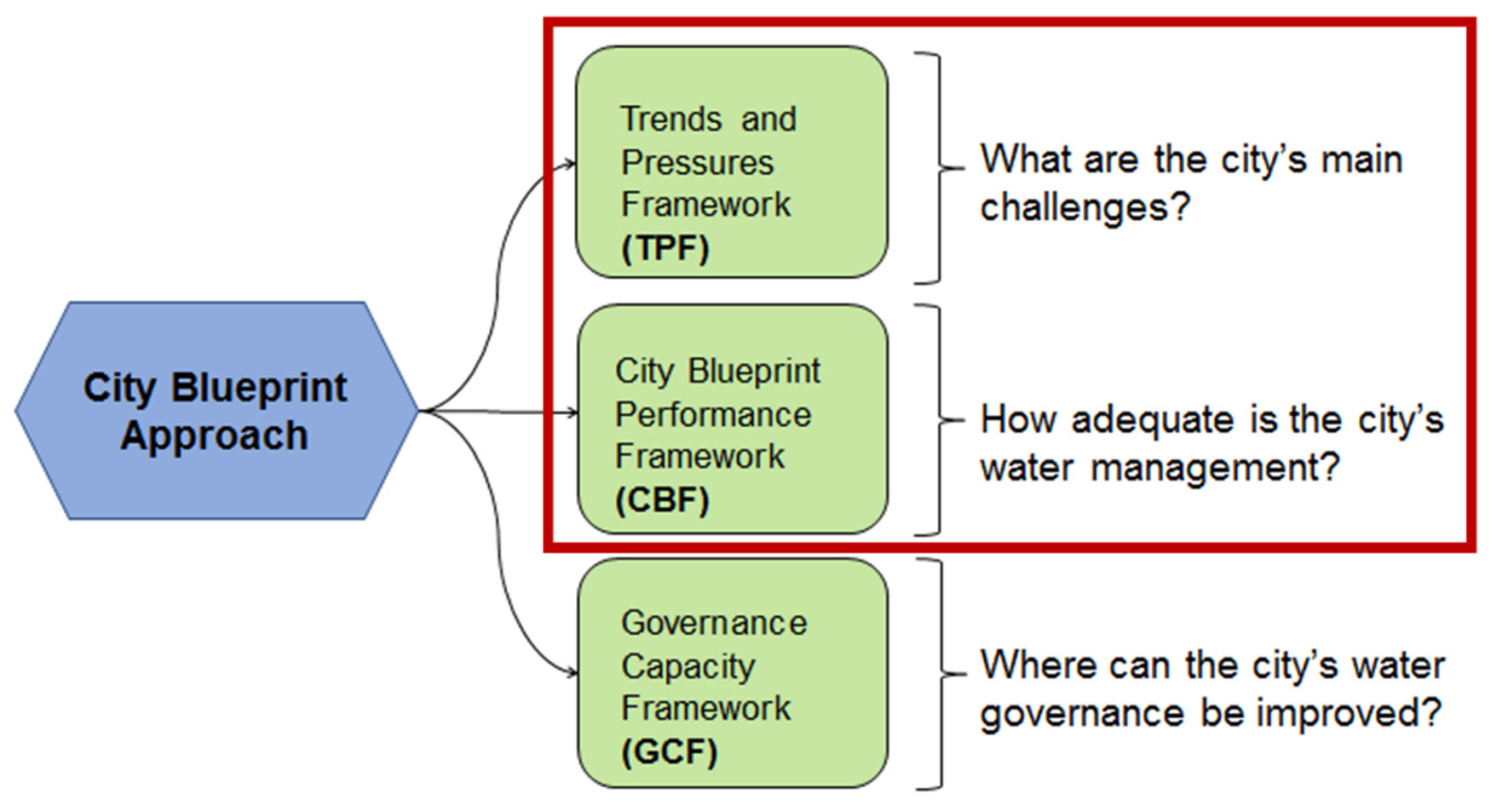
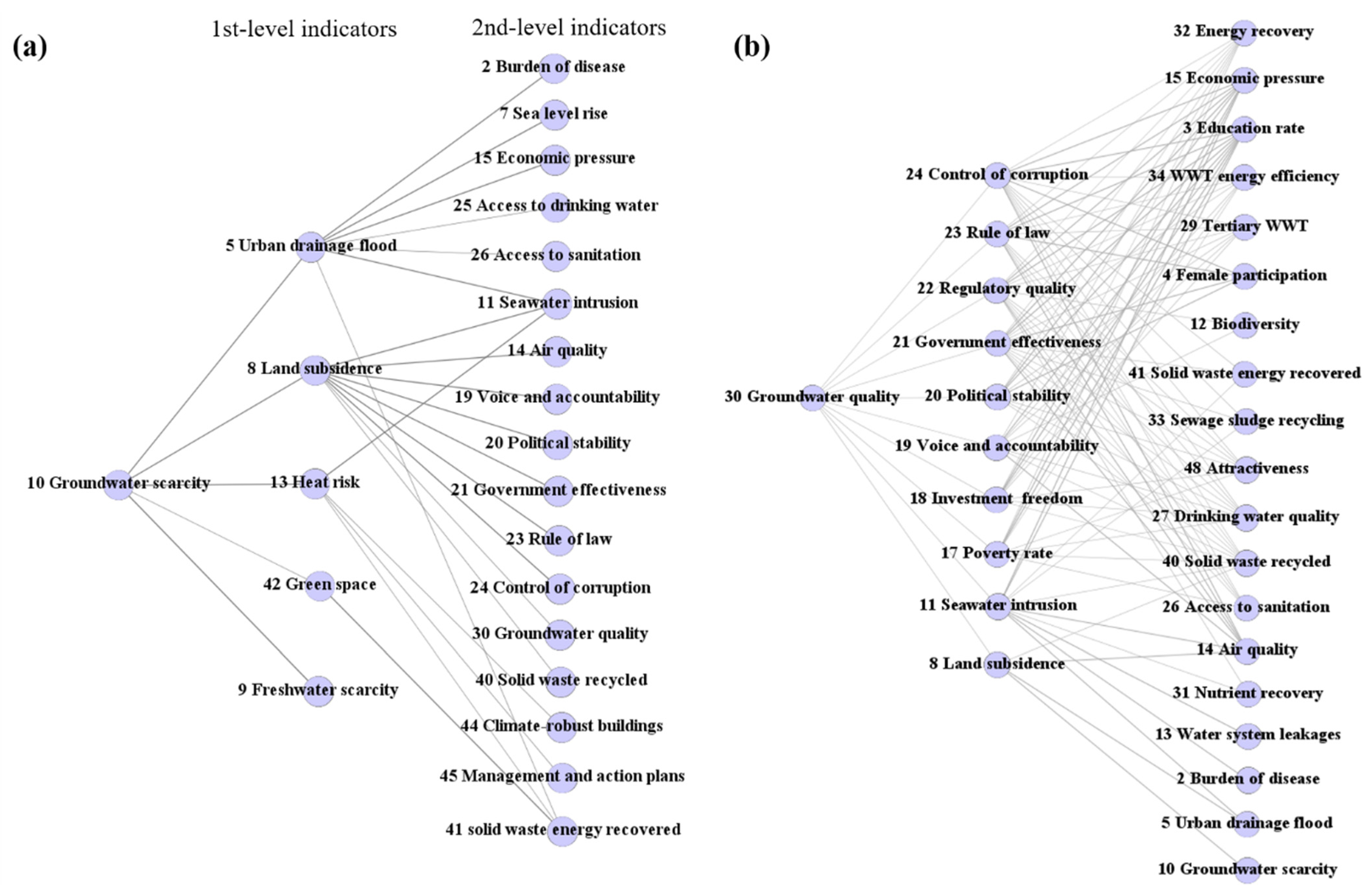
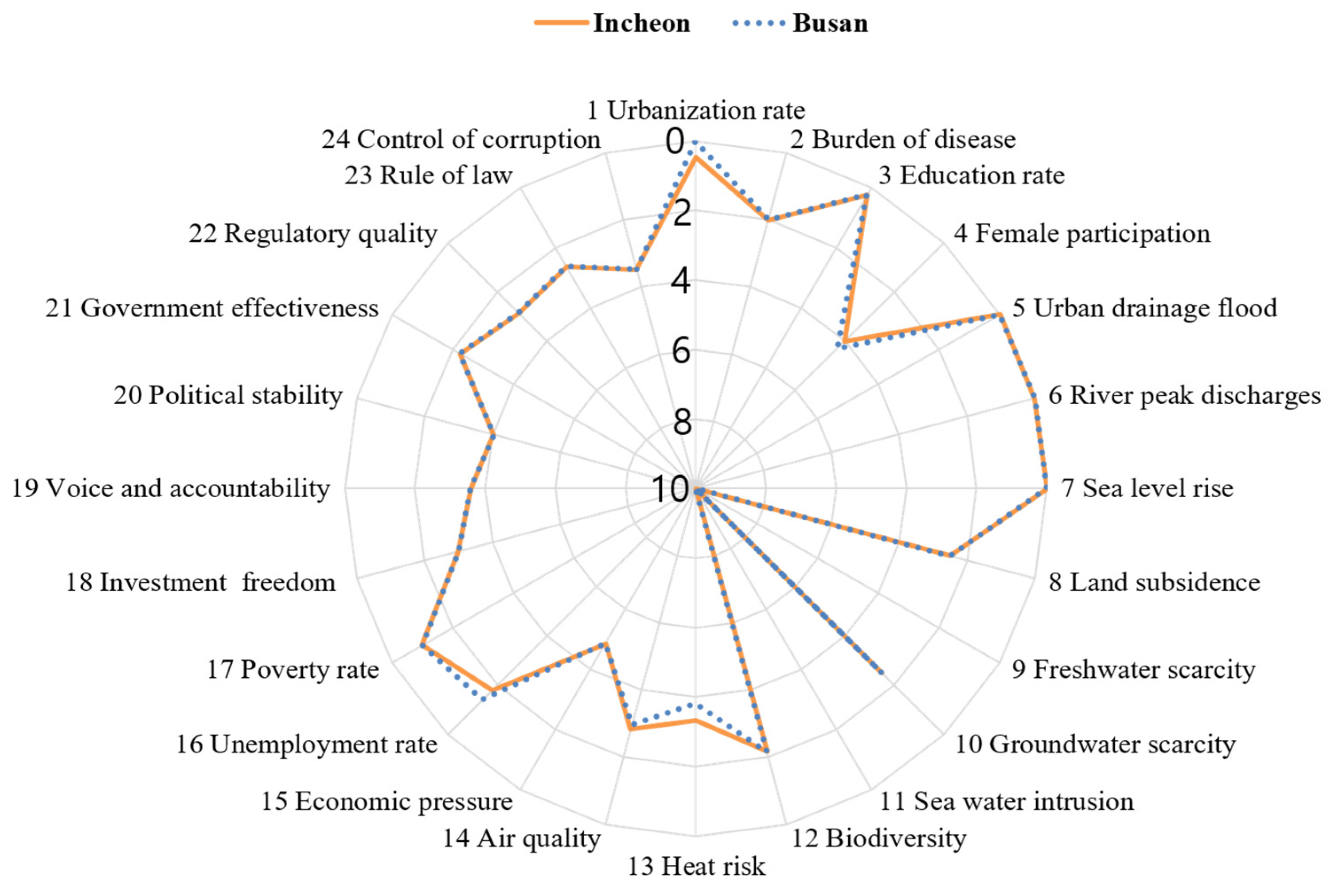
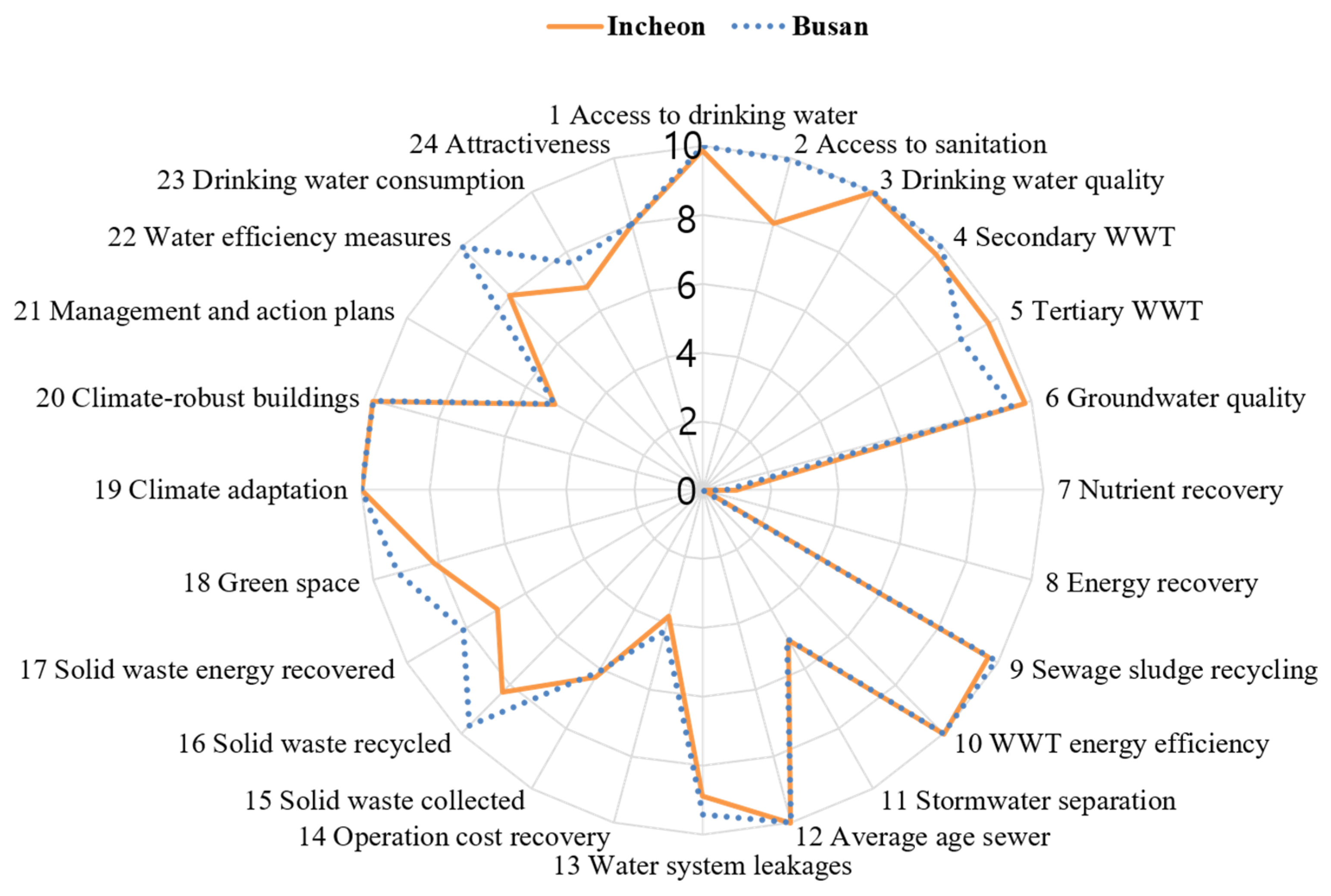
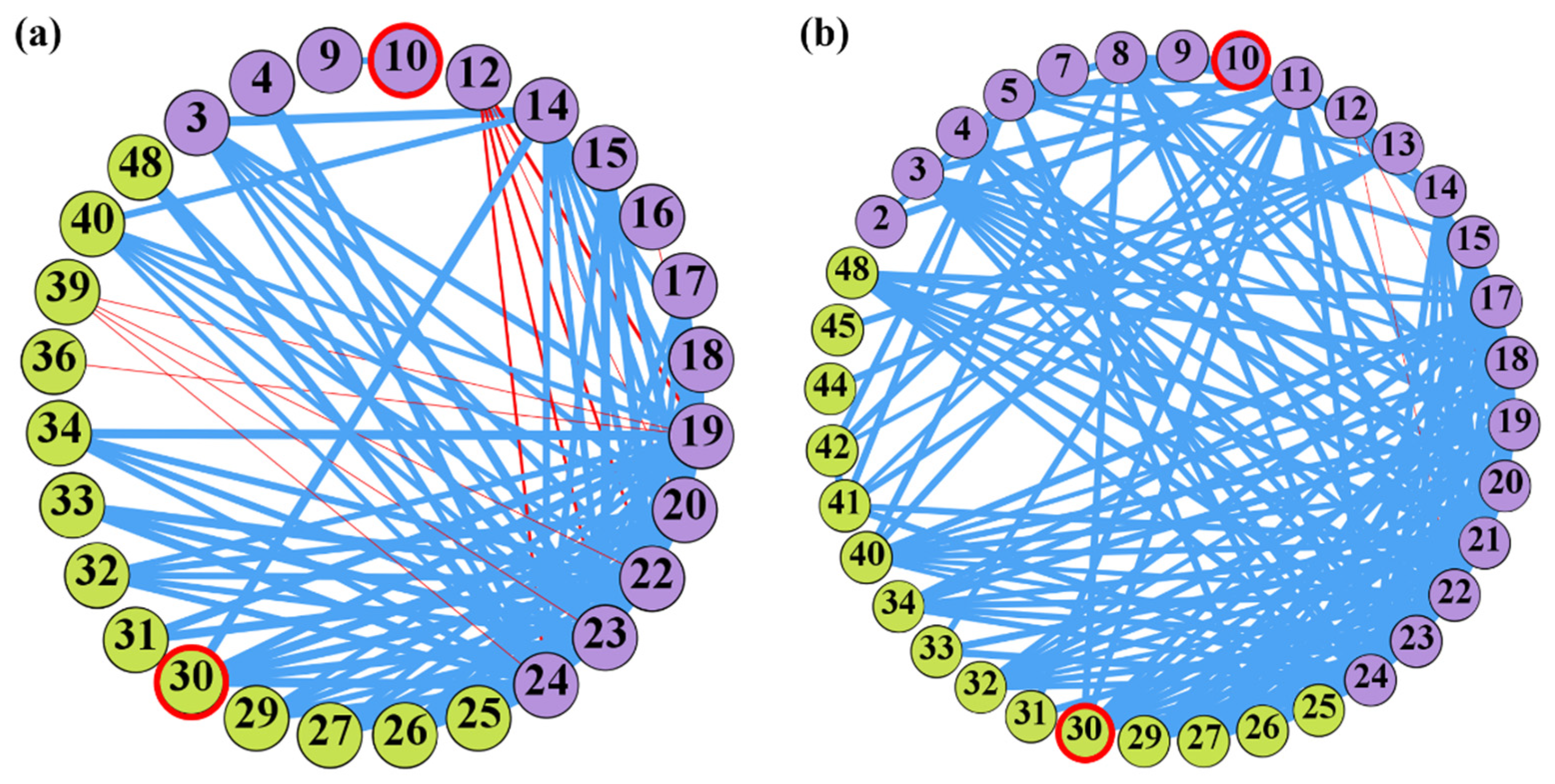
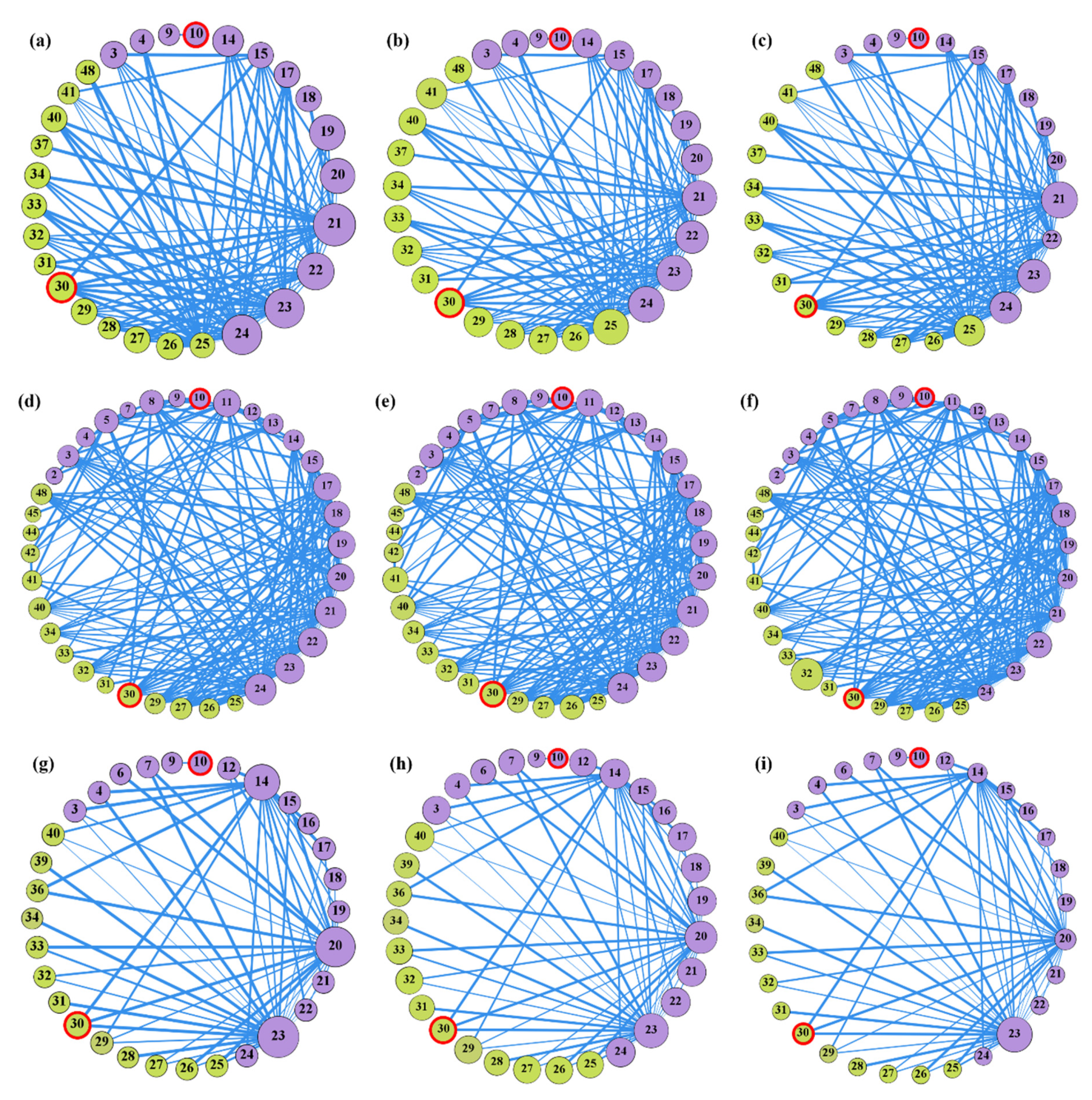

| Trends and Pressures Framework | City Blueprint Framework | ||
|---|---|---|---|
| Social | 1. Urbanisation rate | I. Basic water services | 1. Access to drinking water |
| 2. Burden of disease | 2. Access to sanitation | ||
| 3. Education rate | 3. Drinking water quality | ||
| 4. Female participation | II. Water quality | 4. Secondary WWT | |
| Environmental | 5. Urban drainage flooding | 5. Tertiary WWT | |
| 6. River peak discharge | 6. Groundwater quality | ||
| 7. Sea level rise | III. Wastewater treatment | 7. Nutrient recovery | |
| 8. Land subsidence | 8. Energy recovery | ||
| 9. Freshwater scarcity | 9. Sewage sludge recycling | ||
| 10. Groundwater scarcity | 10. WWT energy efficiency | ||
| 11. Seawater intrusion | IV. Water infrastructure | 11. Stormwater separation | |
| 12. Biodiversity | 12. Average age sewer | ||
| 13. Heat islands | 13. Water system leakages | ||
| 14. Air Quality | 14. Operation cost recovery | ||
| Financial | 15. Economic pressure | V. Solid waste | 15. MSW collected |
| 16. Unemployment rate | 16. MSW recycled | ||
| 17. Poverty rate | 17. MSW energy recovered | ||
| 18. Investment freedom | VI. Climate adaptation | 18. Green space | |
| Governance | 19. Voice and accountability | 19. Climate adaptation | |
| 20. Political stability | 20. Climate-robust buildings | ||
| 21. Government effectiveness | VII. Plans and actions | 21. Management and action plans | |
| 22. Regulatory quality | 22. Water efficiency measures | ||
| 23. Rule of law | 23. Drinking water consumption | ||
| 24. Control of corruption | 24. Attractiveness | ||
| ID | City Blueprint Indicator | ID | City Blueprint Indicator |
|---|---|---|---|
| 1 | TPF 1 Urbanization rate | 25 | CBF 1 Access to drinking water |
| 2 | TPF 2 Burden of disease | 26 | CBF 2 Access to sanitation |
| 3 | TPF 3 Education rate | 27 | CBF 3 Drinking water quality |
| 4 | TPF 4 Female participation | 28 | CBF 4 Secondary WWT |
| 5 | TPF 5 Urban drainage flood | 29 | CBF 5 Tertiary WWT |
| 6 | TPF 6 River peak discharges | 30 | CBF 6 Groundwater quality |
| 7 | TPF 7 Sea level rise | 31 | CBF 7 Nutrient recovery |
| 8 | TPF 8 Land subsidence | 32 | CBF 8 Energy recovery |
| 9 | TPF 9 Freshwater scarcity | 33 | CBF 9 Sewage sludge recycling |
| 10 | TPF 10 Groundwater scarcity | 34 | CBF 10 WWT energy efficiency |
| 11 | TPF 11 Seawater intrusion | 35 | CBF 11 Stormwater separation |
| 12 | TPF 12 Biodiversity | 36 | CBF 12 Average age sewer |
| 13 | TPF 13 Heat risk | 37 | CBF 13 Water system leakages |
| 14 | TPF 14 Air quality | 38 | CBF 14 Operation cost recovery |
| 15 | TPF 15 Economic pressure | 39 | CBF 15 Solid waste collected |
| 16 | TPF 16 Unemployment rate | 40 | CBF 16 Solid waste recycled |
| 17 | TPF 17 Poverty rate | 41 | CBF 17 Solid waste energy recovered |
| 18 | TPF 18 Investment freedom | 42 | CBF 18 Green space |
| 19 | TPF 19 Voice and accountability | 43 | CBF 19 Climate adaptation |
| 20 | TPF 20 Political stability | 44 | CBF 20 Climate-robust buildings |
| 21 | TPF 21 Government effectiveness | 45 | CBF 21 Management and action plans |
| 22 | TPF 22 Regulatory quality | 46 | CBF 22 Water efficiency measures |
| 23 | TPF 23 Rule of law | 47 | CBF 23 Drinking water consumption |
| 24 | TPF 24 Control of corruption | 48 | CBF 24 Attractiveness |
| Netowrk Metrics | Node Strength (s(i)) | Closeness Centrality ) | Betweenness Centrality ) |
|---|---|---|---|
| Diagram | 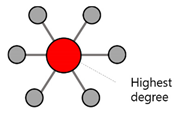 |  | 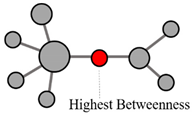 |
| Principal | Assigns an importance score based simply on the sum of edge weight of each nodes. | Scores node based on their ‘closeness’ to all other nodes. The shortest paths between all nodes are calculated, then each node gets a score based on its sum of shortest paths. | Measures the number of times a node lies on the shortest path between other nodes. It shows which nodes are ‘bridges’ between nodes in a network. |
| Application | For finding highly connected indicators that may represent an overarching factor with the indicators that are linked. | Finding indicators that are most interfering with the overall network. Improving these indicators most significantly impacts other indicators. | For finding the indicators that act as key bridges between other clusters of indicators. |
| Calculation | The sum of edge weights connected to node i | The sum of the weighted shortest paths between node i and all other nodes in the network. The weighted shortest path () is calculated as the smallest sum of the weights of the edges throughout all possible paths from node i to j: | The number of the weighted shortest paths that pass through node i. |
| Networks | n | m | <s> | d |
|---|---|---|---|---|
| Entire cities (GT) | 28 | 96 | 11.22 | 2.92 |
| Coastal cities (GC) | 36 | 160 | 15.71 | 3.77 |
| Non-coastal cities (GNC) | 31 | 61 | 6.35 | 3.04 |
| Indicators (ID #) | Centralities Assessed as High | Descriptions of How the Indicator is Correlated with Groundwater | Refs. |
|---|---|---|---|
| Urban drainage flood (5) | s (GC2), ), |
| [53] |
| Land subsidence (8) | s (GC2), ) |
| [54,55] |
| Freshwater scarcity (9) |
| [56,57,58] | |
| Seawater intrusion (11) | s(GC2), ), |
| [59,60] |
| Heat risk (13) | s (GC2), ), |
| [61] |
| Air quality (14) |
| [62,63] | |
| Economic pressure (15) | ) |
| [64,65] |
| Poverty rate (17) | s (GC1), s (GC2) |
| [65,66,67,68] |
| Investment freedom (18) | s (GC2), |
| [69] |
| Voice and accountability (19) | s (GC1), |
| [70,71] |
| Political instability (20) | s (GC1), |
| [72,73,74] |
| Government effectiveness (21) | s (GC1), |
| [75,76] |
| Regulatory quality (22) | s (GC1), |
| [77,78] |
| Rule of law (23) | s (GC1), |
| [79] |
| Control of corruption (24) | s (GC1), |
| [80,81,82] |
| Energy recovery (32) |
| [83,84] | |
| Solid waste recycled (40) | ), |
| [85] |
Publisher’s Note: MDPI stays neutral with regard to jurisdictional claims in published maps and institutional affiliations. |
© 2022 by the authors. Licensee MDPI, Basel, Switzerland. This article is an open access article distributed under the terms and conditions of the Creative Commons Attribution (CC BY) license (https://creativecommons.org/licenses/by/4.0/).
Share and Cite
Lee, K.; Chang, S.; Koop, S.; van Leeuwen, K.; Park, J. Enhancing Informed Decisions for Coastal Groundwater Sustainability: A Network Analysis of Water-Related Indicator Results from 122 Cities. Water 2022, 14, 262. https://doi.org/10.3390/w14020262
Lee K, Chang S, Koop S, van Leeuwen K, Park J. Enhancing Informed Decisions for Coastal Groundwater Sustainability: A Network Analysis of Water-Related Indicator Results from 122 Cities. Water. 2022; 14(2):262. https://doi.org/10.3390/w14020262
Chicago/Turabian StyleLee, Khawon, Sunwoo Chang, Stef Koop, Kees van Leeuwen, and Jeryang Park. 2022. "Enhancing Informed Decisions for Coastal Groundwater Sustainability: A Network Analysis of Water-Related Indicator Results from 122 Cities" Water 14, no. 2: 262. https://doi.org/10.3390/w14020262
APA StyleLee, K., Chang, S., Koop, S., van Leeuwen, K., & Park, J. (2022). Enhancing Informed Decisions for Coastal Groundwater Sustainability: A Network Analysis of Water-Related Indicator Results from 122 Cities. Water, 14(2), 262. https://doi.org/10.3390/w14020262






_van_Van_Leeuwen.png)

